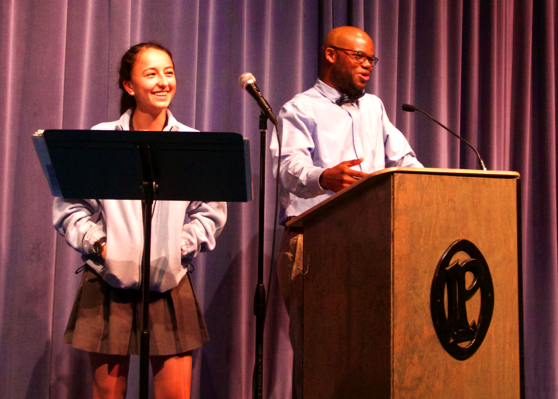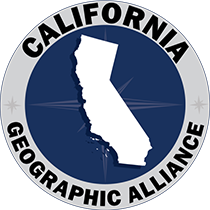How OLP students, in partnership with the California Geographic Alliance, became global citizens
By Laura Rodriguez and Katie Turner
As 10th grade English teachers at the all girls high school, the Academy of Our Lady of Peace (OLP) in San Diego, this year’s World Literature class was an exciting new venture in education for us. Our core curriculum-aligned, backward design gave us an opportunity to think about the overall course, including what texts we could use and what skills we needed our students to develop. More central and critical questions then arose: what learning acquisition do we really want our students to achieve from literature around the world? What do we want our students to know about themselves and their own abilities? With these guiding and essential questions, we were able to design a very unique set of learning opportunities in project-based learning, edu-tech applications, and, most profoundly, the cross-curricular integration of geo-literacy. In earlier newsletters, the CGA has already described aspects of our collaboration in more detail. In this issue, we will speak more directly to our curriculum design.
In Class
We designed our World Literature curriculum around the idea of ‘the hero’ and ‘the journey.’ Our fall semester was dedicated to the antihero (Fahrenheit 451), the tragic hero (Oedipus Rex), the romantic hero (Arthurian quest narratives and the epic medium), and the hero as pilgrim (Dante’s Inferno). While it established credibility in a traditional approach to world literature, it incidentally laid groundwork for the second semester: the female hero and her journey in global literature.
During our spring semester, our students read and viewed texts and films about the rise of the modern woman in society (A Doll’s House, Norway), the struggles of gender traditions and expectations in a 20th Century setting (Nervous Conditions, Zimbabwe), and the role of strict political and fundamentalist religion on these expectations (Persepolis, Iran and Water, India). In doing so, we prepared them for what they would learn, in a project-based context, emphasizing geo-literacy.
Using Social Media
One of the most innovative ways in which our students expanded their study of the female hero in literature was through the integration of Pinterest as a learning tool. Students chose symbolic and metaphorical images to pin on their boards, simultaneously utilizing text to foster innovative approaches to interpretation, composition, and critical thinking. The two ongoing Pinterest assignments included the creation of a superhero board and a country board.
For their Pinterest country board, each student was given one country to follow for the entire semester. We assigned most students to the 50 poorest countries in the world (cross-referenced by the countries with the most egregious disparities in female literacy rates), with the objective of motivating their deeper understanding of a real place with real people. What they discovered was that heroes exist almost everywhere we look! For example, a student assigned to the Democratic Republic of the Congo became interested in the DRC’s history. She independently researched Leopold’s rule, the consequences of Lumumba’s death, and the ripple effect created by Mobutu’s dictatorship. She then began to use the work of journalists like Nicholas Kristof to learn about the humanitarian efforts made in the DRC today. She, just one of 120 sophomores, independently developed an intrinsically motivated inquiry about the past wrongs and the present efforts to bring education, human rights, and peace to that region.
Another example of self-motivated discovery came from a student who lives in Mexico and travels to OLP across the international border every day. She was assigned a country in Central Asia about which she knew nothing. She was initially apprehensive because she bears daily witness to poverty and a lack of services in her own city of Tijuana – why study a faraway place when the problem confronts you everyday? Through her own determination and curiosity, she developed a relationship with a distant culture, language, and set of beliefs only to better understandthe complexity of issues in her own hometown. Teenagers often feel helpless when confronted by global problems, but this geo-literacy project gave them a sense of independent choice that ultimately led to activism in San Diego and Northern Baja; a deeper understanding of Kyrgyzstan offered the tools she needs to understand her community and culture.
For their superhero board on Pinterest, each student developed an alter ego who is not limited to this place or time. Throughout the semester the development of personal superheroes allowed for very flexible and expandable learning modalities. For example, one week we engaged in a discussion about gender-based wage disparity that peaked their interest in the number of women currently holding leadership positions around the world; inspired by the conversation in class, the girls went home, researched current statistics, and added findings to their country boards based on the types of justice issues they care about most. The culmination of this superhero “alter ego” became a collaborative music video project in which students combined the traits of their own superheroes into a 21st Century woman.
Beyond the Classroom
We were awarded a very unique opportunity this year when the California Geographic Alliance chose OLP as a model for geo-literacy in the English classroom. In sending our 10th grade Pilots on an historical, political, geographic, and personal journey through the study of language and literature, our students learned so much about how their lives are integrally connected to the lives of girls around the world. Beyond this, our students were presented with an opportunity to experience a college-level conference, watch a CGA-sponsored screening of Girl Rising, andlisten to and engage with three exciting guest speakers. Along with this symposium, the CGA sponsored an essay contest among the World Literature students, the results of which were published in last month’s newsletter.
This was an amazing and collaborative experience for us as teachers, and we ultimately we attained the goals we built into the 10th grade curriculum; we observed our students become creative, independent, critical thinkers and writers, while analyzing texts that challenge them with real world situations and issues. By expanding our curriculum to include a focus on specific geographical issues, students were able to complement literary texts with real world knowledge on important social and political issues. In doing so, our students have been truly inspired to strive for change. Or in the words of essay winner, Mariana Fernandez, they are inspired to “create commotion,” or small ripples of change as they work to make the world a better place.





